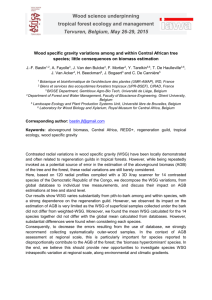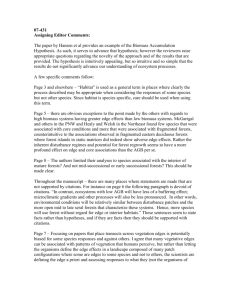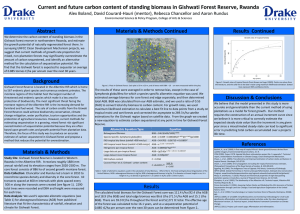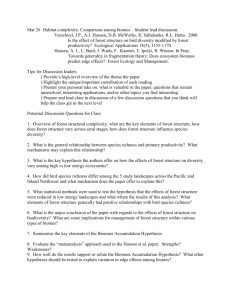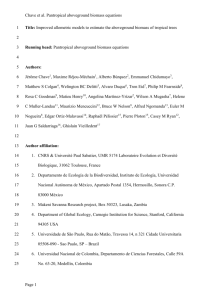File - Ms. Smith`s AP Environmental Science Online
advertisement
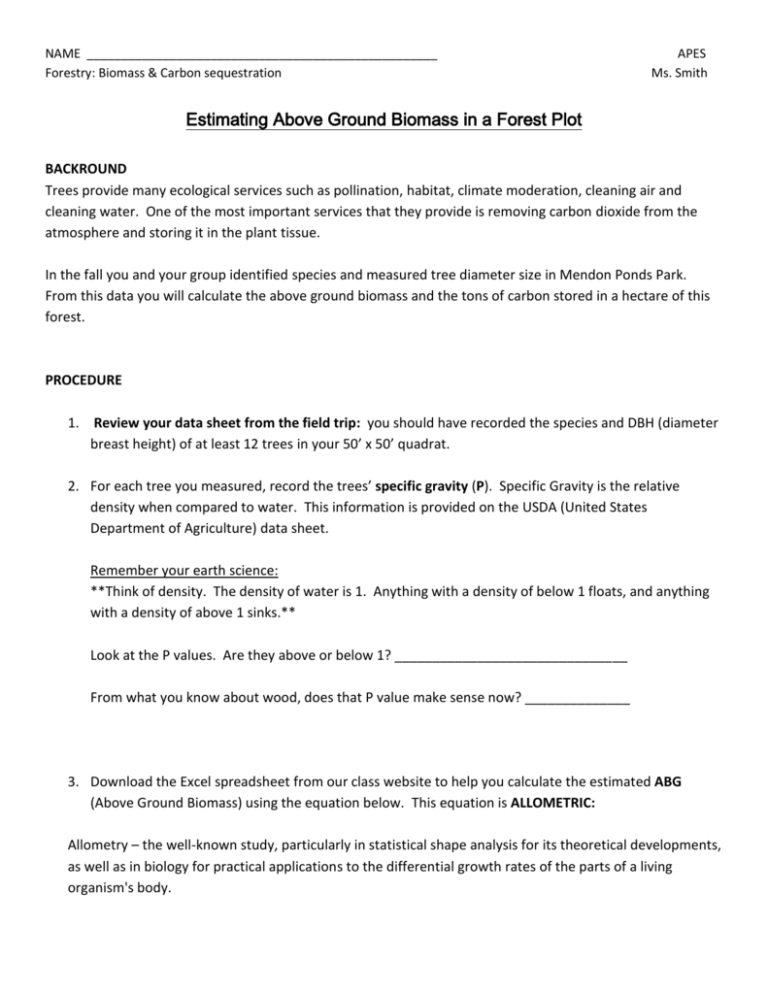
NAME ___________________________________________________ Forestry: Biomass & Carbon sequestration APES Ms. Smith Estimating Above Ground Biomass in a Forest Plot BACKROUND Trees provide many ecological services such as pollination, habitat, climate moderation, cleaning air and cleaning water. One of the most important services that they provide is removing carbon dioxide from the atmosphere and storing it in the plant tissue. In the fall you and your group identified species and measured tree diameter size in Mendon Ponds Park. From this data you will calculate the above ground biomass and the tons of carbon stored in a hectare of this forest. PROCEDURE 1. Review your data sheet from the field trip: you should have recorded the species and DBH (diameter breast height) of at least 12 trees in your 50’ x 50’ quadrat. 2. For each tree you measured, record the trees’ specific gravity (P). Specific Gravity is the relative density when compared to water. This information is provided on the USDA (United States Department of Agriculture) data sheet. Remember your earth science: **Think of density. The density of water is 1. Anything with a density of below 1 floats, and anything with a density of above 1 sinks.** Look at the P values. Are they above or below 1? _______________________________ From what you know about wood, does that P value make sense now? ______________ 3. Download the Excel spreadsheet from our class website to help you calculate the estimated ABG (Above Ground Biomass) using the equation below. This equation is ALLOMETRIC: Allometry – the well-known study, particularly in statistical shape analysis for its theoretical developments, as well as in biology for practical applications to the differential growth rates of the parts of a living organism's body. This equation, an allometric, is based on Mass = Volume x Density. The model is imperfect because it is impossible to determine the exact volume of a large, irregular object like a tree. (See sample calculation on the next page) I have worked out the formula for you and programmed it into the spreadsheet so that you can simply enter the data you have recorded and it will do the calculations for you, which is as follows: AGB = P * exp[ -1.239 + 1.980 ln(D) + 0.207 (ln(D))2 – 0.0281 (ln(D))3] 4. Use the sum of ABG for all of the trees in your hectare to determine the amount of carbon in one hectare of this forest. 5. Use your total ABG to determine the amount of carbon in your hectare. Add the entire class’ data to determine the average per hectare for this particular forest. FACTS: Taking into account the other types of molecules that are found in a tree (proteins, lipids, etc.), we find that about: 45% of the dry mass (not including the water) of a tree comes from carbon. In other words, a 100 kilogram log of a tree that has been completely dried contains about 45 kilograms of stored carbon. \ Relating carbon to carbon dioxide: While each kilogram of dried tree is storing .45 kilograms of carbon, it is removing more than a kilogram of carbon dioxide from the atmosphere. Remember your chemistry: This is because each carbon dioxide molecule contains two oxygen atoms, as shown in this diagram. Using the data from above, this means that each carbon dioxide molecule has an atomic mass of 12 + 2(16) = 44, of which only 12 are due to the carbon. Therefore, for each atom of carbon stored in a tree, 44 atomic mass units of carbon dioxide is removed from the atmosphere. This means that each kilogram of dried tree corresponds to 1 kg / dried tree X .45 kg of C 1 kg of dried tree X 44 amu of CO2 12 AMU of C = 1.65 kg of CO2 We will use the equation Carbon = .45 x AGB SAMPLE CALCULATION: METRIC SYSTEM CONVERSION FACTORS: Suppose that P = .67 and the diameter of your tree is 20 inches. The 20 inches becomes 50.8 cm using the scale conversion factor 1 inch = 2.54 cm. ln = natural log exp = ex Plugging these two values into the equation: AGB = .67 x exp[-1.239 + 1.980 ln (20) + 0.207(ln(20))2 - 0.0281 (ln(20))3] AGB = .67 x exp [-1.239 + 5.93 + 1.857 - .755] AGB = .67 x exp[5.793] AGB = .67 x 327.99 AGB = 219.75 DATA and CALCULATIONS: 1. Transfer your data to the following table and record the specific gravity from the USDA information: TREE Species Specific Gravity DBH inches DBH centimeters A B C D E F G H I J K L Model of Spreadsheet: 1 2 3 4 5 6 7 8 9 10 11 12 13 14 15 A Tree A B C D E F G H I J K L B P C Diam D E F G H AGB kg C To program your own spreadsheet, type the following into a BLANK EXCEL SPREADSHEET: 1. In row 1, type in the bolded boxes (A,B, C … and Tree, P, Diam, etc.) 2. In box D2 type =(LN(C2)) 3. In box E2 type =1.98*D2 4. In box F2 type =0.207*(POWER(D2,2)) 5. In box G2 type =0.0281*POWER(D2,3) 6. In box H2 type =B2*EXP(-1.239+E2+F2-G2) 7. In box H15 insert Autosum. This is the total kg of carbon for your 50’x50’ quadrat. 8. Autofill the equations for each box: D2, E2, F2, G2, H2. 9. Enter your data for specific gravity and DBH in centimeters. 10. Your total kg AGB for a 50’ x 50’ quadrat will be in box H15. CALCULATIONS : 1. The value in box H15 is the total mass in kilograms of biomass in your 50’ x50’ plot. Use this value to calculate the total AGB in metric tons of one hectare of forest. Round to the nearest metric ton. (1000 kg = one metric ton.) 1 acre = 43, 560 ft2 1 hectare (ha) = 2.477 acres 2. Using the equation Carbon = .45 x AGB, calculate the amount of carbon stored (in metric tons) in the biomass of this hectare plot. FOREST DAMAGE: SLASH AND BURN AGRICULTURE, or “Swidden agriculture,” is by far the dominant land use system in the mountainous regions of Southeast Asia (SEA), for example. It provides various valuable subsistence products to local farmers, mostly the poor ethnic minority groups. Controversially, it is also closely connected with a number of environmental issues. Modern Slash and burn Painting by Eero Järnefelt showing forest burning Slash-and-burn practices in Eno, Finland, 1893 THE MAP: Focus on swidden only - Spatial distribution of swidden practice (including shifting cultivation and slash-and-burn agriculture) in pan-tropical developing countries. Literature source: [9,11–25]. QUESTIONS 1. Did the carbon content of your half hectare fall within the range of 65 – 75 tons per hectare of above ground carbon that is stored in temperate forests? What was your answer in metric tons? What seral stage is your forest woodlot? (note: The north east is a temperate deciduous forest) 2. How many tons of CO2 will not be emitted if deforestation is avoided? Remember that for each molecule of CO2, of the 44 mass units, 12 mass units are carbon (2:1 ratio remember your chemistry!). Show your work! 3. Use the following assumptions to measure the carbon offset provided by this intact forest. The biomass of the forest increases at an annual rate of 2.7 x 105 kg/ha The forest biomass is 45% carbon by mass Each year McClancy High School uses 25,000 gallons of fuel-oil for heating 10 kg of CO2 is produced when 1 gallon of fuel oil is burned 1.0 kg of CO2 contains 0.27 kg of Carbon a. Calculate the mass of carbon, in kg, that is accumulated and stored in 1.0 ha of this forest in one year. b. Calculate the mass of carbon, in kg, that is emitted by the school as a result of its fuel-oil consumption. c. Calculate the number of hectares of forest that must be conserved in order to offset the carbon released in one year by the school burning its fuel oil. 4. Using the internet, give TWO reasons why swidden agriculture (slash and burn) has negative impact on climate change. 5. Identify two ecological benefits provided by intact forest ecosystems (other than reducing CO2 levels in the atmosphere)

